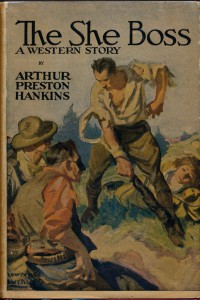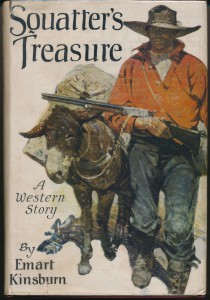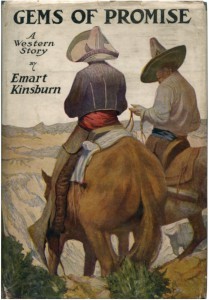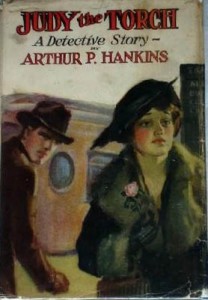San Anselmo has long attracted artists of all varieties who have drawn inspiration from the beauty of the surrounding area or who have found idyllic retreats along the creek, in the hills or wooded canyons. We are fortunate that artists still find the town a most desirable place to live.
This is the story of two men, one an illustrator and portrait painter, the other a writer of short stories and novels, who spent some of their productive years in San Anselmo in the early 20th century.
James Arthur Cahill
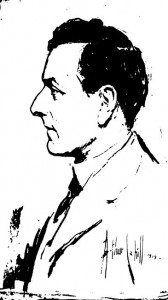
Arthur Cahill, Self Portrait, 1919
James Arthur Cahill was born in San Francisco May 15, 1877 to Irish immigrant parents. He went to work as an office boy in the art department of the San Francisco Examiner at age 11 after his father’s death, but his talents as a sketch artist were soon recognized. In days before newspapers could reproduce photographs, stories were depicted by artists who could draw the scene quickly and accurately. “Young Cahill – still wearing knickerbockers – was one of those who rushed to fire and shooting, riot and suicide with pencil and sketch pad in hand.”
Cahill went on to become a major artist for the Overland Monthly, San Francisco Call, Chronicle, Examiner, Sunset, McClures and the Saturday Evening Post among others. For Harper’s he drew California soldiers departing for the Spanish-American War.
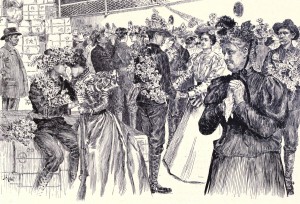
Soldiers departing for the Spanish-American War, Harper’s, 1899
After Arthur Cahill’s first wife, Kate Bente, died in 1911, he moved to San Anselmo the following year with his mother and sister. He purchased a lot at 520 Red Hill Avenue from the Tunstead Company and built a large brown shingle house. The upper floor of the house included a north-facing studio with a skylight where Cahill worked. In October 1918, Cahill married Irene Cazeaux, the daughter of Jean and Therese Cazeaux who owned a hotel and restaurant in town called Villa Cazeaux.
During his years in San Anselmo, Cahill became a noted portrait painter. He traveled to Army camps during WWI and painted life-sized portraits of officers. By 1921, when sixteen of his portraits of distinguished Americans were on display at the Palace Hotel in San Francisco, he was firmly established as one of the country’s foremost portrait painters. General John J. Pershing, Brigadier General Cornelius Vanderbilt, Bank of America founder A. P. Giannini, Adolph Spreckels, Herbert Hoover, Harvey Mudd, John McLaren, William Kent and Governors James Rolph and Hiram Johnson were among the many who sat for him. Several paintings are in the collection of the Fine Arts Museums of San Francisco.
The Cahills left San Anselmo in 1924. Arthur Cahill continued to paint throughout the rest of his long life and died in Oregon in 1970 at age 95. His north-facing studio with the skylight is still a feature of the interior of the house at 520 Red Hill Avenue.
Arthur Preston Hankins
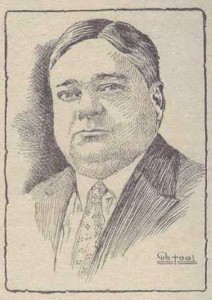
Arthur P. Hankins
Arthur Preston Hankins was already a well-known writer when he and his wife, Emily Washburn Hankins, purchased a home in real estate developer Frank Howard Allen’s new San Anselmo subdivision, Floribel Manor, in 1923. The unique home in a redwood grove, located on Bridge Way (an Allyn Avenue address today), featured a cathedral ceiling with a balcony running the width of the living room; the balcony would serve as Hankins’ retreat where he would write numerous books.
Hankins was born in Sac City, Iowa, in 1880. He spent his early childhood there and in Leoti and Council Grove, Kansas. He was a self-described “noteworthy failure at public school” and was “expelled from two business colleges and a Presbyterian academy.” In 1900 at age 19, Hankins enlisted in the army at Ft. Riley but was discharged ten months later by an Act of Congress which his father was able to arrange. He also married for the first time in 1900 and had one daughter a year later. The marriage didn’t last, and his wife was granted a divorce in 1903.
Restless and without direction, he “jumped on an empty box car one night and became a tramp.” His travels took him to New Mexico where he found work at a large railroad construction camp. Hankins led the tramp life on the road – cooking, tending bar, washing dishes – for a year and half before returning home to his parents and moving with them to California. He wrote: “When we reached California I promptly enlisted in the United States Navy and visited most of the important ports of the Pacific ocean. Then I sold groceries, hot-dogs, tombstones, hardware, shoes, books, raised oranges and alfalfa and took up a homestead 7000 feet above the sea, punched cows, opened a post office, iced fruit trains, and enlisted in the army once more and bought myself out – and, oh, what I didn’t do. The point is that at 30 years of age I began doing what I should have been doing at 20 – writing fiction.”
By his own account, Hankins and his second wife, Emily, whom he married around 1912, lived in twelve California counties before moving to Marin. He wrote over one hundred stories for the popular magazines of the day, New Story Magazine, People’s Favorite Magazine, Western Story Magazine, Argosy All-Story Weekly, and Ranch Romances. The pulp magazines, so named for the cheap quality of paper between the brightly illustrated covers, flourished during the first half of the 20th century. Many authors whose names are widely known today – Edgar Rice Burroughs, Raymond Chandler, and Dashiell Hammett – got their start writing “pulp fiction.”
After eleven years of writing short stories, novellas and silent film scripts, Hankins turned to novels. His first book, The Jubilee Girl, was published in 1921 and was widely acclaimed. It was based on his tramp experiences in the railroad construction camp. He presented a copy of the book to the San Anselmo Library when he moved to town.
While living in his Allyn Avenue retreat, Hankins went on to write over twenty novels under his own name and that of Emart Kinsburn, a pseudonym combining his wife’s name with his (EMily ARThur HanKINS WashBURN).
Hankins was reunited with daughter Josephine and both she and his mother came to San Anselmo to live. Josephine opened a gift shop and lending library somewhere in town in the late 1920s.
The Hankins left San Anselmo in 1931, and Arthur died in January 1932 in San Jose. Today, reprints of many of his books are available; the Historical Museum has a small collection and a listing of his works.


